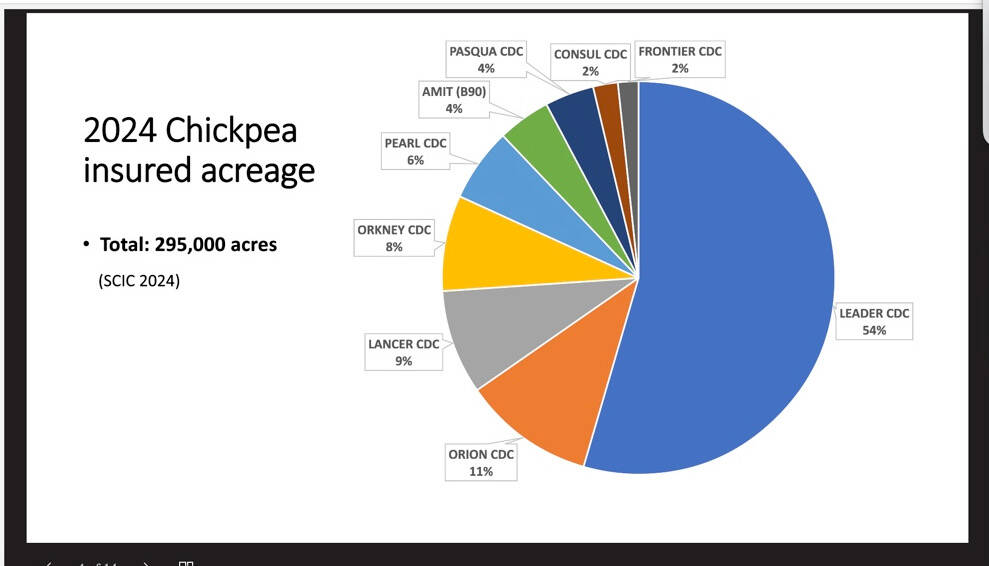WINNIPEG — Shifting away from the old and adopting the new is a normal part of life.
However, that shift often happens at a slow pace.
It’s the case with pulse varieties in Saskatchewan. Farmers are switching to new and improved varieties of peas, lentils and chickpeas, but displacing the established varieties is not easy.
Read Also

U.S. bill could keep out Canadian truckers
The Protecting America’s Roads Act, which was tabled in the U.S. House of Representatives at the beginning of October, would “rid the country of illegal immigrant commercial truck drivers and ineligible foreign nationals.”
During a webinar this winter, SaskPulse shared information on pulse varieties that are fading in popularity and the ones that are gaining traction with growers.
CDC Meadow was planted on 22 per cent of yellow pea acres in the province last year, continuing its reign as the most popular yellow pea in the province, said Laurie Friesen, seed program manager with SaskPulse.
Many farmers are sticking with CDC Meadow, even though it ranked last for yield in trials conducted in the northern and southern growing regions of Saskatchewan.
In the northern region, the top yielding yellow pea varieties were:
- AAC Aberdeen
- CDC Citrine
- CDC Engage
- AAC Profit
- CDC 5845
- In the south:
- CDC Boundless
- CDC Engage
- AAC Chrome
- CDC Tollefson
- AAC Aberdeen
“A lot of these top five varieties are very new. We can see some real yield increases,” Friesen said, noting that detailed information on yield and traits can be found in the SaskSeed Guide.
During her talk, Friesen pointed to a few promising yellow pea varieties that are in the seed multiplication phase and should be available in 2026 or later, such as CDC Boundless and AAC McMuphy.
“There are a lot of new varieties to consider, in the upcoming years.”
Green peas
CDC Forest is the dominant green pea variety in Saskatchewan, capturing 32.4 per cent of acres in 2024. It’s been the most popular green pea since 2021 and that may continue in 2025.
However, a new variety looks extremely promising.
Certified seed for CDC Huskie is expected to hit the market in 2026, Friesen said.
In trials, it produced four to six per cent higher yields than CDC Forest.
“This is a very strong variety…. It has very good standability…. It has improved disease resistance, rated MR (moderately resistant) to fusarium root rot,” she said.
Small red lentils
Like CDC Meadow in yellow peas, an older variety of red lentils remains the most popular with Saskatchewan growers.
CDC Maxim was planted on 29 per cent of acres, even though it ranked last for yield over the last three years of trials.
Three varieties, CDC Maxim, CDC Proclaim and CDC Impulse, represented 74 per cent of Saskatchewan red lentil acres in 2024.
“Maxim acres are slowing decreasing, in favour of Proclaim and Impulse,” Friesen said.
The dominance of those varieties may soon change as a blockbuster red lentil hits the market next year.
Certified seed for CDC Monarch is expected in 2026.
Yields are 10 per cent higher than CDC Nimble and 19 per cent more than CDC Maxim.
It was the highest yielding variety in southern trials and finished second (after Nimble) in the north.
“It is the highest yielding red lentil,” Friesen said, adding its seed size is relatively large and it’s classified as a large red lentil.
Chickpeas
From 2020-22, about 70 per cent of chickpea acres were one variety — CDC Leader.

Bunyamin Tar’an, a University of Saskatchewan chickpea breeder, shared the latest news on chickpeas and varieties in the development pipeline.
Chickpeas have captured more ground in recent years with Canadian seeded acres going from 235,000 in 2022 to 479,000 in 2024.
“Leader is still dominating the acres,” Tar’an said.
“(But) the newer ones are coming to the landscape — CDC Lancer, Orkney and Pasqua.”
Combined, the three varieties captured 21 per cent of acres in 2024.
- CDC Lancer – nine per cent
- CDC Orkney – eight per cent
- CDC Pasqua – four per cent
“We’re starting to see positive uptake of new, higher yielding chickpea varieties,” Friesen said, noting that CDC Orkney is the highest yielding in the dark brown soil zone.
In addition, the latest varieties on the market and those in the pipeline have larger seed size.
“CDC Pasqua is capable of producing 10 millimetre seeds,” Friesen said.
“We are seeing increases in seed size in the varieties developed at … the Crop Development Centre.”


















